
Content
Welcome to the Club of Amsterdam Journal.
The Future Now Show about Africa: A Ticking Bomb with Cristiana Benedetti Fasil
“The demographics of Africa are unique. Sixty percent of the population is below 25 years old. However, millions of youth lack employment and educational opportunities and cannot develop their full potential. Especially girls and young women are disadvantaged. Women are the backbone of the society. Their empowerment is the key to an inclusive and sustainable economic development. We cannot let down the youth of Africa and we need to act now to defuse the ticking bomb of youth unemployment. With Social Venture Africa we want to make our small contribution to address the challenge.”
Felix B Bopp
Founder & Chairman, Club of Amsterdam
Universal Peace Ambassador
Climate disasters increase risks of armed conflicts: new evidence
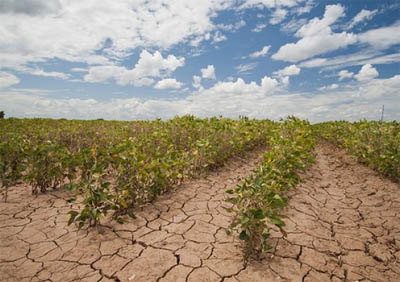
Tobias Ide, Michael Brzoska, Jonathan Donges, Carl-Friedrich Schleussner
The risk for violent clashes increases after weather extremes such as droughts or floods hit people in vulnerable countries, an international team of scientists finds. Vulnerable countries are characterized by a large population, political exclusion of particular ethnic groups, and low development. The study combines global statistical analysis, observation data and regional case study assessments to yield new evidence for policy-makers.
“Climate disasters can fuel some smoldering conflicts – this is a worrying insight since such disasters are on the rise,” says Jonathan Donges at the Potsdam Institute for Climate Impact Research, Germany, co-author of the paper now published in Global Environmental Change. “Ongoing greenhouse gas emissions from fossil fuels are, if unmitigated, destabilizing our climate. More frequent and more severe weather extremes are one of the effects. The new study adds important evidence and hence robustness to conflict analyses we’ve done in the past few years.”
“One third of all conflict onsets in vulnerable countries” is affected
The numbers are quite staggering. “We find that almost one third of all conflict onsets in vulnerable countries over the recent decade have been preceded by a climate-related disaster within 7 days,” says co-author Carl-Friedrich Schleussner from Climate Analytics in Berlin, Germany. “This does, however, not mean that disasters cause conflicts, but rather that disaster occurrence increases the risks of a conflict outbreak.” After all, conflict is human-made. The analysis of concrete cases of disaster-conflict co-occurences shows that most such cases are not mere coincidences, but likely linked by causal mechanisms – this is one of the key new findings.
In Mali for instance a severe drought occurred in 2009 after which the militant Al-Qaeda in the Islamic Maghreb exploited the resulting state weakness and desperation of local people to recruit fighters and expand its area of operation. Other examples analyzed include China, the Philippines, Nigeria, and Turkey. India turns out to be the country with the by far highest number of disaster-conflict coincidences. The most surprising result of the study, says co-author Michael Brzoska from the University of Hamburg, was the prevalence of opportunities for armed violence over those related to grievances in post-disaster situations.
“Measures to make societies more inclusive and wealthier are no-regrets options”
“Climate-related disasters may act like a ‘threat multiplier’ for violent conflicts,” explains Tobias Ide from the University of Melbourne. A most important finding of the study is that only countries with large populations, the political exclusion of ethnic groups and relatively low levels of economic development are susceptible to disaster-conflict links. Optimistically, Ide concludes: “Measures to make societies more inclusive and wealthier are, therefore, no-regrets options to increase security in a warming world.”
Weblink to the article:
www.sciencedirect.com/science/article/pii/S0959378019307307
A Fast, Fair and Effective Solution to the Climate Crisis

By Brigitte Van Gerven, on behalf of the Citizens’ Climate Lobby Europe, Brussels, April 05, 2020
Contact: brigittevangerven@citizensclimatelobby.be
In her pre-election manifesto My Agenda for Europe Ursula von der Leyen outlined her ambition that Europe become the first climate neutral continent. She acknowledged that to make this happen, carbon emissions must have a price, that every person and every sector will have to contribute, and that what is good for the planet must also be good for the people of Europe. In particular she expressed the need for a “just transition for all.” The challenge of dealing with the climate crisis is therefore two-fold. The technical challenge of reducing CO2 emissions, and the social challenge of financing the transition in a way that citizens will see as “just.”
An important idea which could go a long way to achieving these goals is the idea of a Carbon Fee and Dividend. Many economists are strongly in favor of this approach and have long advocated the introduction of this policy. In January 2019, an open letter on the subject was published in the Wall Street Journal. In the largest joint statement by economists in history, it was signed by more than 3,500 economists, including 27 Nobel Prize laureates, 4 former chairs of the Federal Reserve and 15 former chairs of the US Council of Economic Advisors.
The principle is simple. A steadily rising fee is imposed on all fossil fuels, proportional to their CO2 emissions. This will drive down carbon pollution since companies, industries, the public sector and consumers will move toward cleaner, cheaper options. It will speed up the phasing out of fossil fuels, and will dramatically boost green investments, accelerating the development and large-scale commercialization of low-carbon technologies. The money collected from the carbon fee is then distributed equally among all citizens. This Dividend or Climate Income ensures that the average cost of living does not increase. The majority of households, among which most lower- and middle-income households, may even benefit from this policy. The Carbon Fee and Dividend is therefore a game-changer allowing politicians to pursue an ambitious climate policy widely supported by the population. The mechanism is self-funding, so no new budgets are needed to implement the policy. A major advantage in times of economic crisis and rising budget deficits.
This idea is gaining popularity worldwide. Since 2008 it has been implemented in Switzerland. Since April 2019 it has being implemented in Canada. The Energy Innovation and Carbon Dividend Act is currently being put to the US Congress with bipartisan support. The idea has now spread to 13 countries.
The Climate Fee and Dividend provides a fast, fair and effective response to the climate crisis. It needs to be given serious consideration in Europe. Citizens Climate Lobby Europe is leading a European Citizens Initiative, to do just that. The goal of the initiative is to put the carbon fee and dividend approach on the legislative agenda for Europe. But for this to work we do need something more.
A comprehensive study of the feasibility and benefit of this scheme was carried out in the US in 2014 by REMI. It concluded that the approach would lead to a rapid decrease in CO2 emissions, the creation of 2.8 million new jobs, and the avoidance of 230 000 premature deaths due to a reduction in air pollution. We need to do a similar study for Europe. Citizens Climate Lobby in Europe is therefore advocating that a similar study be undertaken by European economists, to assess the impacts of this promising policy on the European economy, and to provide guidance on how it might be implemented across the EU and its member states.
To find out more about the carbon fee and dividend, about the work of the Citizens Climate Lobby in Europe, there are 2 Facebook Live events coming up, on Saturday May 2 and Friday June 3, at 17.00hrs CET. You can also consult the following websites and sign the petition for a Climate Income Now.
” CCL Belgium: https://www.citizensclimatelobby.be
” CCL Europe: https://citizensclimateinitiative.eu
” CCL USA: https://www.citizensclimatelobby.org
The Future Now Show
Shape the future now, where near-future impact counts and visions and strategies for preferred futures start. – Club of Amsterdam
Do we rise above global challenges? Or do we succumb to them? The Future Now Show explores how we can shape our future now – where near-future impact counts. We showcase strategies and solutions that create futures that work.
Every month we roam through current events, discoveries, and challenges – sparking discussion about the connection between today and the futures we’re making – and what we need, from strategy to vision – to make the best ones.
May 2020
Africa: A Ticking Bomb
with
Cristiana Benedetti Fasil
“The demographics of Africa are unique. Sixty percent of the population is below 25 years old. However, millions of youth lack employment and educational opportunities and cannot develop their full potential. Especially girls and young women are disadvantaged. Women are the backbone of the society. Their empowerment is the key to an inclusive and sustainable economic development. We cannot let down the youth of Africa and we need to act now to defuse the ticking bomb of youth unemployment. With Social Venture Africa we want to make our small contribution to address the challenge.”
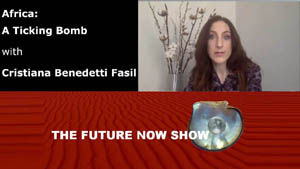
The Future Now Show
Credits
Cristiana Benedetti Fasil, President and Co-founder of the NGO Social Venture Africa, www.svafrica.org
Researcher at the Directorate General Joint Research Centre of the European Commission
Green New Deal for Europe
Striving to be the first climate-neutral continent
Climate change and environmental degradation are an existential threat to Europe and the world. To overcome these challenges, Europe needs a new growth strategy that transforms the Union into a modern, resource-efficient and competitive economy where
- there are no net emissions of greenhouse gases by 2050
- conomic growth is decoupled from resource use
- no person and no place is left behind
The European Green Deal is our roadmap for making the EU’s economy sustainable. This will happen by turning climate and environmental challenges into opportunities across all policy areas and making the transition just and inclusive for all.
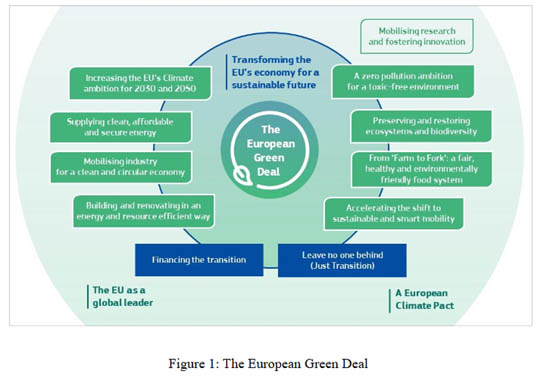
Von der Leyen: Outlining the European Green Deal
Jeremy Rifkin at DLD Munich 20
Jeremy Rifkin has been an advisor to the leadership of the European Union since 2000. He has advised three presidents of the European Commission – Romano Prodi, Jose Manuel Barroso, and the current President, Jean-Claude Juncker – as well as the European Parliament, and numerous EU heads of state, including Germany’s Angela Merkel, on the ushering in of a smart green Third Industrial Revolution economy.
News about the Future

Solar Windows
convert sunlight that passes through their tiny solar cells. These cells are placed at precise angles to collect light that comes through the window near the window frame. These panels, called “solar concentrators,” funnel light to capture ideal sunlight on the solar spectrum coming through the glass.
See: Physee

Energy self-sufficient households in Switzerland by 2050?
Researchers from ETH Zurich investigated whether it would be technically and economically feasible for households to achieve energy self-sufficiency using photovoltaics alone in the temperate Swiss climate by the middle of the century.
The analysis suggests that total self-sufficiency is technically feasible by 2050 for single- and multi-family buildings in Switzerland across a range of scenarios. Self-sufficiency is most easily attainable for single-family households that successfully lower their energy demand through behavioural change and urban vehicle use patterns, meaning less frequent use over shorter distances.
The predicted financial feasibility of self-sufficiency depends on several factors, including (hypothetical) government incentives and the savings from the decreasing cost of energy-storage technologies. All fully self-sufficient buildings are more expensive than buildings that are fully electrified but still connected to the grid, but so are households that still use fossil fuels for heating and vehicles. “In other words, electrification is definitely economically beneficial for households, but complete self-sufficiency comes at a cost premium,” adds Stefan Pfenninger, Department of Environmental Systems Science, ETH Zurich
5G is Bad For Our Health – Not!
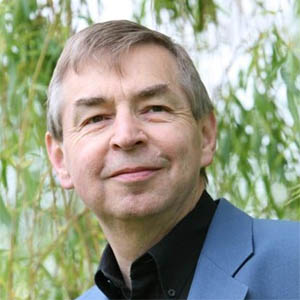
By Professor Peter Cochrane OBE, Cochrane Associates Co-Founder, Sentient Systems University of Suffolk UK
https://petercochrane.com
Every paper that I have seen concerned with the adverse effects of wireless on humans and organisms under the broad banner of EM radiation employ words and phrases like: might, could, possibly, perhaps, and we think, it seems, and so on! Many also end with that fateful phrase; ‘further study is required,’ which I presume is a prelude to yet another grant application.
As far as I can see the 100’s of such publications do not present concrete statements, demonstrations or conclusions and there is no real or verifiable risk in evidence! Now a small detail: Many/most studies employ energy densities far in excess of those we use in any of our wireless communication systems. They have to do this to demonstrate small biological changes, but they then proceed to extrapolate down to the far lower energy levels than are actually allowed in our wireless systems. The basis of the extrapolations tend to be linear simplifications of fundamentally exponential mechanisms! This is a gross error and does not constitute proof! More worrying is the lack of corroboration between groups of these bona fide researchers!The plot thickens! Complementing all this are ever more pseudo-scientific papers from people with impressive CVs in various magazines and dubious on-line publications. These are oft quoted as evidence by the already convinced, easily convinced, or wanting/needing to be convinced!What a travesty! Every one of these I have investigated has been nonsense, non-science, neo-science, a combining of belief, misconceptions, falsehoods and erroneous claims sans fact checking or corroboration!Now to some impressive empiricism! At every cell site, wifi-hub, microwave repeater station and radar facility I have visited there have been no dead insects, birds, mice or rats on or around the antenna or the tower base.
Further, there has never been any recorded damage to humans using hand-held or vehicle mounted walkie talkies, and man-pack radios over the past 70 years…apart from back strain that is!The other side of the coin: Mobile technology has saved countless lives and lifted peoples out of poverty all over the planet. 5G and what follows will accelerate all this through low latency enabling tele-medicine, tele-care, tele-surgery, tele-robotics, and tele-manufacturing et al. Now, if only the single dimension/issue thinkers could balance the proven good/gain against some (still) fictitious danger/threat they may, just may, be able to stop panicking about a non-problem and think rationally!Now to the extremists and crazies burning down cell sites in the UK.
Right now all the 5G systems being installed are using the same/similar frequencies to 3/4G and wifi hubs! But all microwave links and hubs, satellite broadcast, links and services and radar systems are in the frequency domains they worry about. And I think we can safely say that none of this magically created and propagated CV-19!So, how’s the down-side of their actions working out? They are most likely killing people! The loss of cell sites will prevent 999 calls, delay ambulances and fire service dispatch and control, and worse, disable sectors of the national emergency services network!How did all this madness get started? The rantings of a deranged, ignorant, crazy in the USA supposing to be a scientific expert appears to be the point of nucleation.
So, in the home of the brave and land of the paranoid; where ‘Mary on FaceBook’ is an authority on everything and must be believed, where science has little or no value, until there is a pandemic or a war that is, the movement started a social media campaign and the planet wide spread of another crazy meme got underway.Sad to say that all this has now been picked up by uneducated vandals in the UK. But don’t worry! Next month they will be chasing the next big threat!
Watch also
The Future Now Show
5G with Peter Cochrane
https://clubofamsterdam.com/2020/06/15/5g/
Recommended Book

Resilience Thinking: Sustaining Ecosystems and People in a Changing World
by Brian Walker, David Salt
Increasingly, cracks are appearing in the capacity of communities, ecosystems, and landscapes to provide the goods and services that sustain our planet’s well-being. The response from most quarters has been for “more of the same” that created the situation in the first place: more control, more intensification, and greater efficiency. “Resilience thinking” offers a different way of understanding the world and a new approach to managing resources. It embraces human and natural systems as complex entities continually adapting through cycles of change, and seeks to understand the qualities of a system that must be maintained or enhanced in order to achieve sustainability. It explains why greater efficiency by itself cannot solve resource problems and offers a constructive alternative that opens up options rather than closing them down. In Resilience Thinking, scientist Brian Walker and science writer David Salt present an accessible introduction to the emerging paradigm of resilience. The book arose out of appeals from colleagues in science and industry for a plainly written account of what resilience is all about and how a resilience approach differs from current practices. Rather than complicated theory, the book offers a conceptual overview along with five case studies of resilience thinking in the real worlad. It is an engaging and important work for anyone interested in managing risk in a complex world.
The Animal Communicator Anna Breytenbach
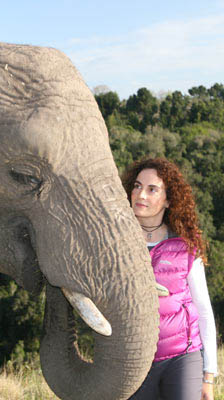
What if you could talk to animals and have them talk back to you? Anna Breytenbach has dedicated her life to communication. She sends messages to animals through pictures and thoughts, and receives messages back! Anna can feel the scars hidden under a monkeys fur or turn a snarling leopard into a contented cat.
ENHANCING THE RELATIONSHIP BETWEEN HUMANS, OTHER ANIMALS AND THE NATURAL WORLD
Human and animal communication creates a valuable bridge between human and non-human animals. By connecting with our intuition, we can engage in meaningful dialogue and remember how to hear the subtle messages from those whose space we share in our lives and our natural environment. Coming from a place of respect and reverence for all life, we can learn to understand our wilder relatives, honour their truths and live in greater harmony.
Anna’s role is communication, guidance and mentoring. She is based in the Western Cape, South Africa and offers workshops in various locations as well as consulting via phone and email for local and international clients. The goals of any consultations, public talks, animal communication workshops or nature retreats are increased awareness, empathy, compassion and mutual understanding.
Climate Change Success Story: Sustainable Rubber

By Seow Lye Lok, Singapore
Currently in full-time employment with a local medical school as a media engagement specialist and research communication editor.
Southeast Asia is responsible for 90 per cent of global natural rubber production, but the industry faces significant social and environmental challenges.
World Business Council for Sustainable Development (WBCSD) is a global, CEO-led organization of over 200 leading businesses working together to accelerate the transition to a sustainable world. We help make our member companies more successful and sustainable by focusing on the maximum positive impact for shareholders, the environment and societies.
Our member companies come from all business sectors and all major economies, representing a combined revenue of more than USD $8.5 trillion and 19 million employees. Our global network of almost 70 national business councils gives our members unparalleled reach across the globe. Since 1995, WBCSD has been uniquely positioned to work with member companies along and across value chains to deliver impactful business solutions to the most challenging sustainability issues.
Together, we are the leading voice of business for sustainability: united by our vision of a world where more than 9 billion people are all living well and within the boundaries of our planet, by 2050.
What is sustainable rubber?
Rubber is one of the world’s most widely used materials, but irresponsible farming methods have led to deforestation and human rights abuses as the sector has grown. Could there be a better way? Eco-Business explores the potential for sustainable natural rubber.

Image: Shutterstock
Bouncy, elastic, compressible and moldable — the unique properties of natural rubber make it one of the most widely used materials, found in products from pencil erasers and birthday balloons to condoms and protective gloves.Today nearly 50 per cent of every auto tire and 100 per cent of all aircraft tires are made of natural rubber. Even the invention of synthetic rubber and rubber-like plastics has not stunted demand for this natural material made from a milky sap known as latex, harvested from a tree native to the Amazon region, the Brazilian rubber tree (Hevea brasiliensis). In the last two decades, demand for natural rubber, 85 per cent of which is grown in Southeast Asia, has been increasing at a rate of 5 per cent a year.However, over the centuries since rubber plantations took root, life has not become much better for smallholder farmers, who produce more than 80 per cent of the crop worldwide. In Thailand, the world’s biggest rubber exporter, the country’s 2 million rubber farmers, many of them migrant labour from poorer neighbouring countries, earn as little as 200 baht (US$6) a day, and the use of methamphetamine is common as workers are pressured to harvest at ever faster speeds.Meanwhile tropical forests are being lost at an alarming rate as they are cleared to make way for rubber plantations, threatening biodiversity in the world’s most species-rich regions. “As global demand for rubber products shows no sign of slowing, models of ‘business as usual’ scenarios have predicted major habitat conversion to rubber plantations at a possible further five million hectares globally by 2024,” says Vina Dharmarajah, Asia director of Birdlife International.As consumers and the companies that buy rubber grow more discerning about rubber’s environmental and social impacts, so the pressure builds on the industry to produce sustainable natural rubber (SNR), grown in a way that protects forests while meeting rising demand for the commodity.Eco-Business looks at how rubber can be grown sustainably, who’s buying SNR, and how to build the movement for sustainable rubber cultivation.
1. The impact of rubber farming in Southeast Asia
Farming rubber sustainably is complex and expensive, and requires an overhaul of traditional farming practices.Deforestation has historically been driven by high rubber prices, which is why it is critical that farmers increase yield to ensure that, when prices rise again, increased rubber production does not come at a cost for forests.Unsustainably-managed rubber plantations can create severe air pollution if, to clear land quickly and cheaply, it is slashed and burned, which has a major impact on forest flora and fauna.Due to the heavy use of herbicides to clear the land to manage the risk of snake bites, animal species that depend on the destroyed plants quickly succumb too. Furthermore, rain erodes the exposed earth, deteriorating the soil quality and exacerbating crop growth problems.Rubber trees are susceptible to blight. Scientists have cautionedthat a single spore of South American leaf blight reaching Southeast Asia could wipe out a substantial portion of the industry.
2. How can rubber be grown sustainably?
The process for cultivating natural rubber sustainability involves a few key steps, from land preparation to planting and harvesting.To avoid the negative effects of expanding rubber plantations, land use planning should be based on a solid understanding of rubber farming constraints and their ecological impacts. Local governments and research institutes can use remote sensing studies as a reference point to promote sustainable rubber cultivation.Before establishing a plantation, growers need to obtain land use permission from indigenous communities who live on or near the land, a process the United Nations Permanent Forum on Indigenous Issues defines as free, prior and informed consent (FPIC).It takes about seven years for a rubber tree to mature before it can produce rubber for tapping, and how the crop is planted, harvested and cleared affects the sustainability of the plantation. For example, intercropping rubber with timber trees and medicinal plants counters the ill effects of monoculturing.In October 2018, an independent platform for sustainable rubber cultivation, the Global Platform for Sustainable Natural Rubber (GPNSR), was set up with support from the World Business Council for Sustainable Development to improve the sustainability of the natural rubber value chain.GPSNR director Stefano Savi, who joined the organisation six months ago from the palm oil industry’s lead certifier, Roundtable on Sustainable Palm Oil (RSPO), said: “We work with players in the natural rubber industry, as well as NGOs to help a move towards sustainably produced natural rubber. GPSNR will consider the people, communities and natural resources touched by natural rubber production, in a global and truly multi-stakeholder effort to drive improvements in the socio-economic and environmental performance of the natural rubber value chain.”In a nutshell, sustainable rubber farming makes rubber cultivation profitable while minimising harm for people and the planet, and GPSNR aims to chart a course for the rubber industry that avoids the problems that have blighted the agricultural sector: deforestation, land grabbing and human rights violations.
3. What are the barriers to joining the sustainable natural rubber movement?
Many of the problems with growing a responsible natural rubber sector come from the higher initial cost of growing rubber trees sustainably. It costs more to pay fair wages that buffer farmers from market uncertainties. But over the long term, higher pay ensures that farmers do not switch to other crops such as palm oil, or resort to unsustainable agricultural farming methods that lead to lower yield and greater environmental impact.Currently, rubber supply is higher than demand, which gives buyers the upper hand — including tire companies that want to reduce their environmental footprints. Some of the founding members of the GPSNR, including German carmaker BMW and tire manufacturer Bridgestone, are already leading industry-wide efforts to kick-start the SNR movement.
4. Where can I find sustainable rubber products?
The low market prices paid to rubber tappers, plantation workers and smallholder farmers make it difficult for them to support themselves and their families. By supporting ethical procurement suppliers, companies may be paying a premium, but will help ensure the long-term sustainability in rubber supply and market stability. An early way to address the problem came through associations such as the Fair Rubber Association and World Wide Fund for Nature, which advocated for sustainable rubber production. GPSNR has emerged out of a desire from multiple stakeholders to define and implement a sustainable natural rubber system.
5. Who’s using sustainable rubber?
By joining GPSNR, which is working on standards to protect biodiversity and water resources, improve yields, and increase supply chain transparency and traceability, rubber-buying businesses can get access to a broad network of resources and contacts for practical sustainability solutions for their supply chains.Some companies have already started on their journey towards sustainable rubber. GPSNR member rubber producers have committed to sustainable production, and a number of buyers have made ambitious pledges to source sustainable rubber. In 2017, General Motors became the first car firm to commit to responsible rubber sourcing. BMW and Toyota have since done the same.Tire manufacturer Michelin — the world’s largest buyer of natural rubber — was the first tire maker to commit to responsible rubber sourcing in 2016. Competitors Pirelli, Goodyear, Sumitomo, Continental, Yokohama, Hankook, Toyo Tires and Bridgestone have since followed.Bridgestone Americas’ senior counsel, environmental, health safety and sustainability, Andy Thompson, says his company has worked hard over the last year to understand how its suppliers are living up to sustainability standards. “Sustainable natural rubber across the value chain will come through collaboration with responsible partners within the value chain and civil society,” he says.
Futurist Portrait: Ken Dychtwald
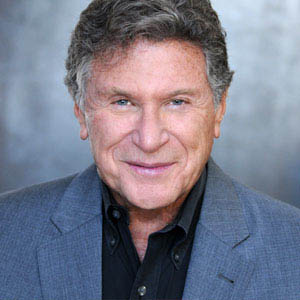
Dr. Ken Dychtwald has assembled a highly skilled and enthusiastic team of seasoned professionals to work with the world’s leading corporations. The team provides innovative solutions for customizable presentations, a wide range of landmark research initiatives, the production of high-impact publications and media projects, and proven business-building tools for financial professionals.
Individually and collectively, the Age Wave team brings to each project a wealth of knowledge and experience about the social, lifestyle, marketing, and financial implications of an emerging mature marketplace. Their talents and experience span a broad range of industry sectors from consumer goods to healthcare, manufacturing to retail, nutrition to financial services, advertising to media, and more.
Over the past 35+ years, Dr. Ken Dychtwald has emerged as North America’s foremost visionary and original thinker regarding the lifestyle, marketing, health care, and workforce implications of the age wave.
Ken is a psychologist, gerontologist, and best-selling author of 16 books on aging-related issues, including Bodymind; Age Wave: The Challenges and Opportunities of an Aging Society; Age Power: How the 21st Century Will Be Ruled by the New Old; The Power Years: A User’s Guide to the Rest of Your Life; Healthy Aging; Workforce Crisis: How to Beat the Coming Shortage of Skills and Talent; Gideon’s Dream: A Tale of New Beginnings and, most recently, A New Purpose: Redefining Money, Family, Work, Retirement, and Success. He is currently writing two new books, What Retirees Want: A Holistic View of Life’s Third Age (to be released July 15, 2020) and The Sorcerer’s Apprentice: Lessons from an Irregular Life. He was the executive producer and host of the highly rated/acclaimed PBS documentary, The Boomer Century: 1946–2046.
Since 1986, Ken has been the Founder and CEO of Age Wave, a firm created to guide companies and government groups in product/service development for boomers and mature adults. His client list has included over half the Fortune 500, and his explorations and innovative solutions have fertilized and catalyzed a broad spectrum of industry sectors—from pharmaceuticals and medical devices, to automotive design and retail merchandising, to financial planning and health insurance.
He has served as a fellow of the World Economic Forum and was a featured speaker at two White House Conferences on Aging. Ken has twice received the distinguished American Society on Aging Award for outstanding national leadership, and American Demographics honored him as the single most influential marketer to baby boomers over the past quarter century. His article in the Harvard Business Review, “It’s Time to Retire Retirement,” was awarded the prestigious McKinsey Award, tying for first place with the legendary Peter Drucker. PBS Next Avenue named him a 2016 Influencer in Aging for his work pushing beyond traditional boundaries and changing our understanding of what it means to grow older. Ken was honored by Investment Advisor as one of the 35 most influential thought leaders in the financial services industry over the past 35 years. Ken and his wife, Maddy, recently received the Esalen Prize for their outstanding contributions to advancing the human potential of aging men and women worldwide. He was also awarded the Inspire Award from in the International Council on Active Aging for his exceptional and lasting contributions to the active-aging industry and for his efforts to make a difference in the lives of older adults globally.
During his career, Ken has addressed more than two million people worldwide in his speeches to corporate, association, social service, and government groups. His strikingly accurate predictions and innovative ideas are regularly featured in leading print and electronic media worldwide and have garnered more than ten billion media impressions.
In addition to his role at Age Wave, he is deeply involved in numerous activities for the public good including serving as a member of the XPRIZE Board of Trustees.
How the Age Wave Will Transform Health, Longevity & Medicine with Ken Dychtwald






Customer Reviews
Thanks for submitting your comment!